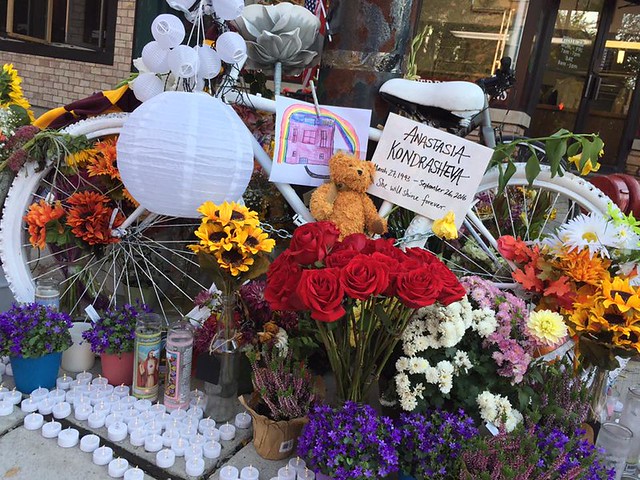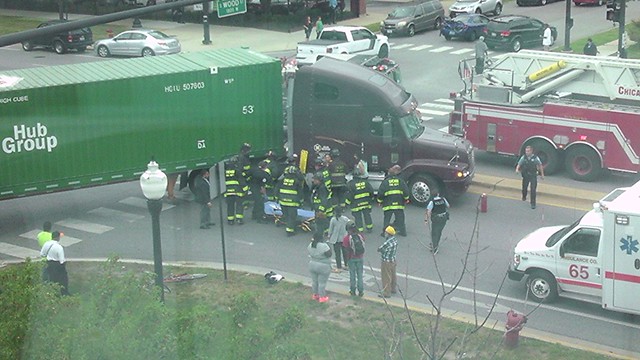
[Last year the Chicago Reader launched a weekly transportation column written by Streetsblog Chicago editor John Greenfield. This partnership allows Streetsblog to extend the reach of our livable streets advocacy. We syndicate a portion of the column after it comes out online; you can read the remainder on the Reader’s website or in print. The paper hits the streets on Thursdays.]
It's every bicyclist's nightmare: You're riding on an arterial street, perhaps in a bike lane, when a truck appears on your left. The driver fails to check for bikes before making a right turn, causing a "right-hook" crash. The truck blocks your path, you're struck, and you fall under the massive vehicle. The rear wheels roll over your body, causing severe, likely fatal, injuries.
Variations of this worst-case scenario resulted in the deaths of two young adults in Chicago this summer—25-year-old Virginia Murray and 20-year-old Lisa Kuivinen. (Two other people, courier Blaine Klingenberg and security guard Frank Cruz, were killed by commercial vehicle drivers while biking this summer, and a third person, pizzeria worker Nick Fox, died in late September from injuries he suffered after being hit by a pair of trains while riding last June.)
Recently two more truck-bike crash fatalities were added to the list. On September 22 during the evening commute, 18-year-old Northwestern student Chuyuan Qiu rolled out of a parking lot on the university's Evanston campus and was run over and killed by concrete truck driver who was heading north on the 2000 block of North Sheridan Road. Police said Qiu was struck by one of the wheels and fell under the vehicle.
And four days later, 23-year-old health coach Anastasia Kondrasheva was fatally struck while biking to work in Edgewater. She'd been heading north on Damen at Addison in Roscoe Village when a 38-year-old male flatbed truck driver turned right in her path, killing her instantly.

A candlelight vigil and “ghost bike” installation for Kondrasheva took place last Friday, drawing some 300 people. The local group Ghost Bikes Chicago, which provided the white-painted bicycle, installed a ghost bike for Qiu in Evanston on Tuesday.
Chris Spicer, co-owner of Lakefront Supply Company, told WGN-TV that he witnessed Kondrasheva's crash, and that the flatbed truck (belonging to a different company) was just like the ones his employees drive.
"In my mind, I saw [one of my trucks]," Spicer said. "I saw my driver on the ground sobbing uncontrollably because he just took someone's life."
In an effort to make sure that never happens, later that week Spicer had fender-mounted mirrors installed on all nine of Lakefront's flatbed trucks, which should reduce their blind spots.
That may be a good approach for helping truckers see bicyclists before they strike them. Meanwhile, there's a growing movement in U.S. cities to require side guards or side rails on large trucks as a strategy to reduce the damage if a crash occurs. These devices—already widespread in Europe, Japan, Brazil, and other countries—prevent pedestrians and cyclists who are struck by trucks from going under the vehicle and being crushed by the rear wheels.
It's likely that side guards could have made a difference for Murray, Kuivinen, Qiu, and Kondrasheva. Therefore, we should push Chicago's City Council to require the equipment on large trucks operating in the city, in order to prevent more truck-bike crash fatalities.
Side guards have been proven to reduce serious injuries and deaths when vulnerable road users are hit by the side of a truck. After 1986, when Great Britain began requiring the equipment on most new trucks, the fatality rate for turning-truck crashes dropped by 20 percent for pedestrians and 61 percent for cyclists. (Last week London mayor Sadiq Khan proposed banning semitrucks from the city altogether by 2020, since these vehicles were involved in 58 percent of cyclist deaths in that city over the last two years.)



